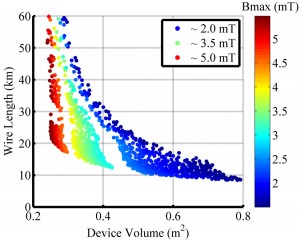Field Containment and Robustness in Design of Air-Core Superconducting Machines
Field Containment and Robustness in Design of Air-Core Superconducting Machines
MSEE student David Loder with adviser K. Haran
Two important challenges in the design of air-core superconducting machines include cost reduction and field containment within the device. Traditional solutions to the field-containment problem incorporate passive magnetic shielding, e.g., an eddy current shield, or a ferromagnetic back yoke. While effective, the prior solution increases losses to unacceptable levels, and the latter greatly adds to the device weight, eliminating some of the power density advantage allowed by higher field superconductor devices. To address this challenge, an actively shielded electromagnet design, an approach commonly used in MRI magnet designs, is considered. This topology utilizes a set of main coils to produce the armature flux density, while including another set of oppositely excited compensating coils to mitigate the fields radiating outside the machine. However, this substantially increases the superconductor wire usage. In order to investigate the tradeoff between power density and wire usage, prior work employed a multi-objective optimization scheme for a 10 MW device; machine volume and wire length were set as the two optimization objectives, given a fixed external field requirement.
The effect of the external field requirement was investigated to increase robustness and flexibility for different industry requirements. Instead of setting a fixed requirement, the external field was given as a third objective to minimize in the optimization. The external field is computed at one meter from the device. The results are shown in Fig. 1, with the external field requirement plotted in color. Three field levels are chosen for easy viewing of the tradeoffs. It can be seen that changes in field requirement can greatly impact device performance. For lower field levels outside the device, a worsening tradeoff is obtained between power density and wire usage. For example, a design using 20 km of superconductor, with 5 mT external field, can be made 0.18 m2 more compact (a 40% improvement) as compared to a design with a more stringent shielding requirement of 2 mT. A cross section of an example optimized design is given in Fig. 2
This research is supported by NASA LEARN account NASA NNX15AE41A.

